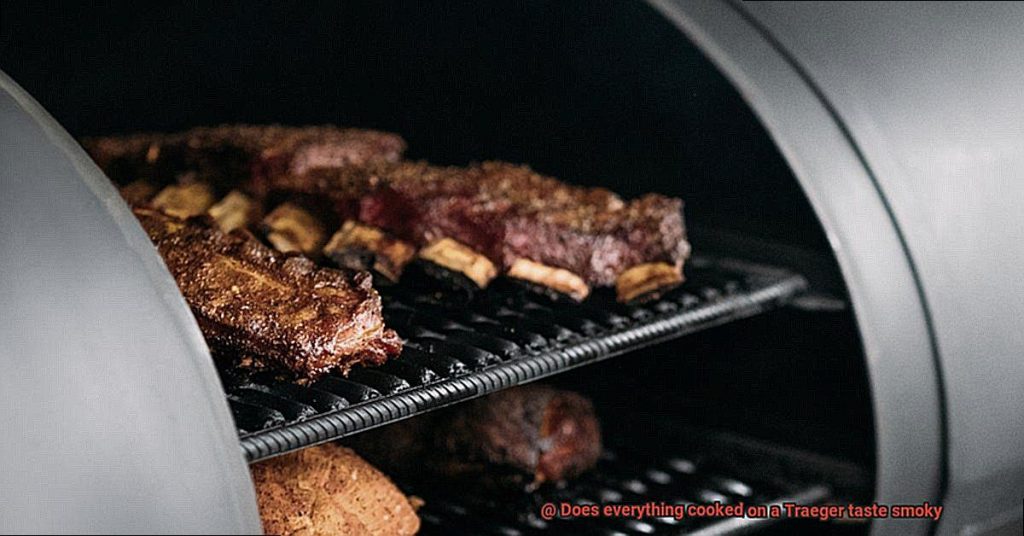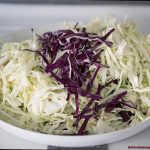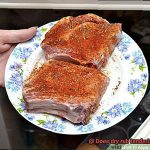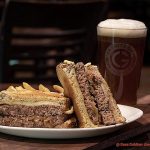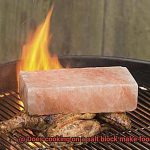Welcome to the world of Traeger grills, the ultimate outdoor cooking machine that has taken the culinary world by storm. If you’re a grilling enthusiast, you know that Traeger grills are versatile and can smoke, bake, roast, barbecue, and grill all types of food. But if you’re new to Traeger grilling, you might be wondering – does everything cooked on a Traeger taste smoky?
The answer is no. Although Traeger grills use wood pellets to fuel the fire and produce heat, not all dishes will have a deep smoky flavor. The level of smokiness depends on several factors such as the type of wood pellets used and cooking temperature. Luckily for us, Traeger grills come equipped with a temperature control system that allows us to choose the temperature and cooking time for our food.
Some Traeger users prefer hickory or mesquite pellets for a more intense smoky flavor while others opt for milder fruitwood pellets like apple, cherry or maple for a more subtle smoke profile. As meat lovers ourselves, we highly recommend experimenting with different wood pellets to achieve unique smoky flavors in your beef, pork, chicken or fish dishes.
In this blog post, we’ll debunk the myth that everything cooked on a Traeger tastes smoky and explore various factors that affect the level of smokiness in your food. Whether you’re new to Traeger grilling or an experienced pro looking to take your skills up a notch – join us as we delve into the world of Traeger grilling and discover how to infuse your food with delicious flavors without necessarily making it too smoky.
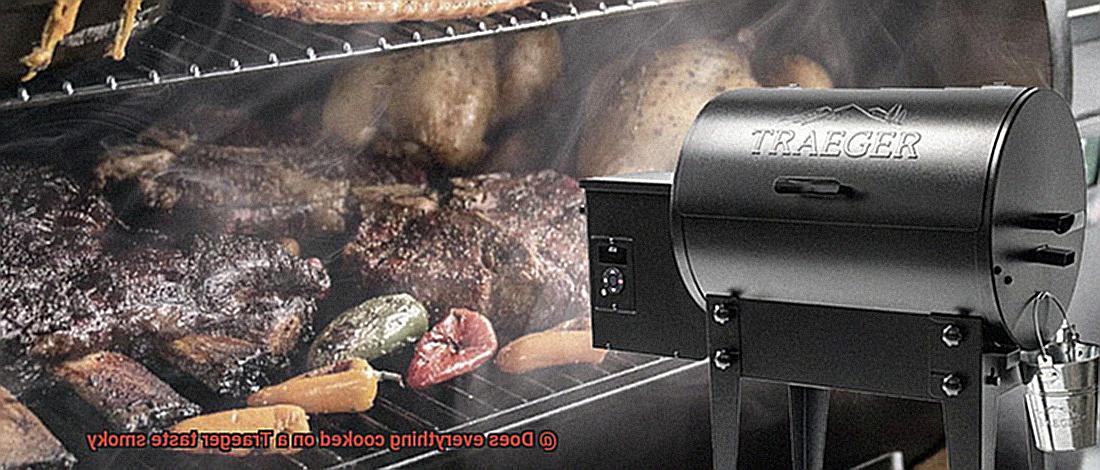
Contents
What is a Traeger Grill and How Does it Work?
Enter the Traeger Grill, a wood pellet grill that is revolutionizing the backyard BBQ scene.
So what exactly is a Traeger Grill and how does it work? Simply put, it uses wood pellets as its source of fuel and heat. The electrically powered auger feeds the pellets into a fire pot, which ignites and produces heat and smoke. The heat and smoke are then circulated around the cooking chamber, resulting in evenly cooked food with a delectable smoky flavor.
But what sets the Traeger Grill apart from traditional grills? Its digital controller. With this feature, you can set the temperature and cooking time for your food, ensuring consistent results every time you use the grill. This means no more constant monitoring or adjusting of heat levels.
What’s more, the Traeger Grill’s versatility allows for a wide variety of cooking methods. You can grill, smoke, roast, bake, and even braise all on the same grill. Say goodbye to multiple appliances cluttering up your outdoor space.
Now, you may be wondering if everything you cook on a Traeger Grill will have that signature smoky taste. The answer is no – the level of smokiness depends on several factors such as the type of wood pellets used and cooking temperature. Experiment with different pellets and cooking techniques to find your preferred smoky flavor intensity.
The Role of Wood Pellets in Creating Smoky Flavor
Then you need to know about the crucial role that wood pellets play in creating that irresistible smoky flavor on a Traeger grill.
Wood pellets are the key ingredient in a Traeger grill, made from compressed sawdust and wood shavings. But it’s not just any wood used – various woods like hickory, applewood, mesquite, cherry, pecan, oak, and more are used to add different smoke flavors to the pellets. The flavor profile will vary depending on the type of wood pellet used.
Looking for a bold and intense smoky flavor? Hickory pellets are your go-to. Prefer a milder and sweeter taste? Then applewood pellets are the perfect choice. Traeger offers a wide variety of wood pellet flavors to suit any taste preference.
However, it’s important to note that not all foods cooked on a Traeger grill will have a smoky taste. Several factors affect the amount of smoke flavor absorbed by your food. Cooking temperature, cooking time, and surface area are some of the critical factors that determine the amount of smoke flavor in your food.
Cooking foods at lower temperatures for longer periods will result in more smoke flavor than cooking at high temperatures for short periods. Foods with more surface area will also absorb more smoke flavor than those with less surface area.
So how do you achieve that perfect smoky flavor? Experimentation is key. Try different types of wood pellets and cooking techniques to find the perfect balance of smoke flavor that suits your taste buds. Traeger offers a wide range of wood pellet flavors like mesquite, cherry, pecan, and oak to help you get creative with your cooking.
Temperature and Cooking Time: Impact on the Level of Smokiness
Let’s explore how these factors impact the flavor of your food.
Firstly, let’s talk about temperature. When using a Traeger grill, wood pellets are used as fuel and are fed into the fire pot by an auger. The heating rod then ignites the pellets to create a flame that heats up the grill.
The temperature you set your grill at can greatly affect how much smoke is produced. If you want a deep smoky flavor, opt for a lower temperature of around 225-250°F.
This will allow your food to absorb more smoke and develop a rich flavor. For a lighter smoky taste, go for a higher temperature of around 450-500°F for a shorter cook time.
Cooking time is equally important when it comes to achieving the perfect level of smokiness.
The longer your food spends on the grill, the more smoke it will absorb. This is why slow-cooked meats like brisket and pulled pork have such a deep smoky flavor – they spend hours on the grill soaking up the goodness.
But if you’re short on time and still want some smokiness, try adding wood pellets to your grill’s fire pot at the end of your cook for a quick infusion of flavor.
It’s worth noting that not everything cooked on a Traeger grill will have a strong smoky flavor. The intensity depends on several factors such as the type of wood pellets used, the temperature at which you cook your food, and how long you cook it for. So don’t be afraid to experiment with different combinations until you find your perfect match.
Different Types of Dishes and Their Ability to Absorb Smoke Flavor
Then cooking on a Traeger grill might just be the answer you’re looking for. But not all dishes are created equal when it comes to absorbing smoke flavor. Here are some key things to keep in mind:
Meats are a perfect match for infusing with smoke flavor. Brisket, ribs, and chicken are just a few examples of meats that have a porous texture that allows the smoke to deeply penetrate the meat. However, the intensity of the flavor can vary depending on the type of wood pellets used and the length of cooking time. So, get ready to experiment with different pellets and cooking times to get the perfect smoky taste.
Vegetables and fruits may not be as receptive to smoke flavor as meats, but there are ways to enhance their taste. Smoking them in a foil packet or adding a smoke-infused sauce can help bring out their full flavor potential. Vegetables like eggplant and mushrooms have a meaty texture that makes them even more receptive to smoky flavors.
Seafood is another dish that can be challenging to infuse with smoke flavor due to its delicate texture. Using a mild wood pellet and cooking at a lower temperature for a shorter amount of time will help avoid an overpowering smoky taste. Fish, in particular, has a delicate texture that can easily become overpowered by too much smoke.
Baked goods like cakes and cookies don’t typically benefit from being cooked on a Traeger because the smoke can overpower their delicate flavors. So, it’s best to stick with traditional baking methods for these types of dishes.
Heavily seasoned or sauced dishes may not benefit from being cooked on a Traeger either, as their strong flavors can compete with the smoky taste. It’s important to find the right balance between seasoning and smoky flavor to avoid an overwhelming taste.
Tips for Infusing More Smoke Flavor into Your Dishes
Here are five tips to help you achieve that perfect smoky taste:
Choose the Right Wood Pellets
The type of wood pellets you use is crucial in determining the intensity of smoky flavor in your dishes. For a stronger smoky flavor, opt for hickory or mesquite pellets. Fruitwood pellets like apple or cherry have a milder smoke flavor that may not be as noticeable. Experiment with different wood pellet flavors to find the perfect one for your dish.
Preheat Your Grill
Preheating your grill for at least 15 minutes is essential to ensure that the wood pellets fully ignite and create smoke, resulting in a more flavorful dish.
Cook Low and Slow
Cooking low and slow is the key to obtaining a good smoky flavor. This allows the smoke to penetrate the meat and infuse it with flavor. Take your time and let your food cook slowly over a lower temperature.
Use a Smoke Box
If you’re not getting enough smoke flavor from your Traeger, consider using a smoke box. A small metal box filled with wood chips placed on the grill grates will create more smoke and infuse your food with additional flavor.
Avoid Opening the Lid Too Often
Every time you open the lid of your Traeger, you release heat and smoke, decreasing the intensity of the smoky flavor in your dish. Try to avoid opening the lid too often, especially during the first few hours of cooking.
Benefits of Cooking with a Traeger Grill
Look no further than a Traeger grill. While many people associate Traeger grills with their signature smoky flavor, these versatile grills offer so much more.
First and foremost, Traeger grills are incredibly versatile. Unlike traditional grills that use direct heat, Traeger grills use indirect heat and wood pellets, allowing for more precise temperature control. This means you can cook everything from juicy steaks to perfectly roasted veggies to delectable desserts. And because Traeger grills use wood pellets instead of charcoal or propane, they produce less smoke and fewer harmful chemicals.
Another major benefit of cooking with a Traeger grill is consistency. With precise temperature control and even heat distribution, you can be confident that your food will come out perfectly cooked every time. This is particularly important for delicate foods like fish or veggies.
But what really sets Traeger grills apart is how easy and convenient they are to use. Simply set the temperature, add your food, and let the grill do the work. No need to worry about constantly monitoring the temperature or flare-ups like you would with a traditional grill. And with digital controllers and Wi-Fi capabilities, you can even monitor and control your grill from your smartphone.
wz9SCmyY5NA” >
Conclusion
In conclusion, Traeger grills have revolutionized outdoor cooking and become a popular choice for many grill enthusiasts. However, the burning question remains: does everything cooked on a Traeger taste smoky? The answer is not necessarily.
The level of smokiness depends on various factors such as the type of wood pellets used, cooking temperature, and duration. With a temperature control system, Traeger grills allow us to adjust the temperature and cooking time for our food with ease.
Wood pellets are crucial in creating that irresistible smoky flavor on a Traeger grill. Different woods like hickory, applewood, mesquite, cherry, pecan, oak offer varied smoke flavors to the pellets.
While meats are perfect for infusing with smoke flavor, vegetables and fruits may not be as receptive to smoke flavor as meats. Seafood is another dish that can be challenging to infuse with smoke flavor due to its delicate texture. Additionally, heavily seasoned or sauced dishes may not benefit from being cooked on a Traeger either.
To achieve that perfect smoky taste on your dishes, preheat your grill for at least 15 minutes before cooking low and slow. It’s also essential to choose the right wood pellets and consider using a smoke box if you’re not getting enough smoke flavor from your Traeger. Avoid opening the lid too often during cooking as this could affect the smoking process.
Overall, Traeger grills offer versatility in terms of experimentation with different combinations of wood pellets and cooking techniques until you find your preferred smoky flavor intensity.

